What is so compelling about the idea of life lasting until an organism gives up the ghost of its own accord?
Tag: animal predation
Zen and the art of deer hunting
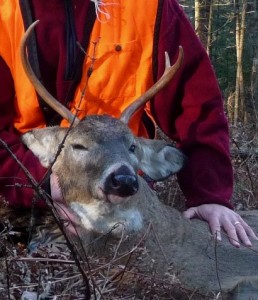 Don’t try too hard, some folks say. Desperation can drive the deer away. The less you expect, the more animals you see.
Don’t try too hard, some folks say. Desperation can drive the deer away. The less you expect, the more animals you see.
How this philosophy dovetails with the undeniable value of perseverance, I’m not sure. But there may be something to it.
In my first few years as a hunter, I dragged home exactly zero pounds of venison. It was only in my fourth autumn—after I gave up on getting a deer and decided to focus on just enjoying my time in the woods—that my first buck came along.
The next year, I had no expectation of repeated success so soon. Yet a deer came. The year after that, with less time to hunt, my expectations were even lower. Again, a deer came.
There are limits to such luck, however.
This fall, I would be too busy to spend much time in the woods. (Of late, I’ve been too busy even to spend much time in the wilds of the internet. As fellow bloggers can attest, my forays there have left few traces in the form of comments.) I felt sure our freezer would hold no venison this winter. But I promised myself I would get out for a few mornings, just to feel the forest wake at dawn.
A week ago, on opening morning of rifle season, I was doing just that. I had reached the woods a full hour before sunrise: half an hour before legal shooting light.
In the dark, I heard one deer somewhere behind me, its hooves crunching leaves. But its meandering, start-and-stop movements sounded more like a doe browsing than a buck seeking a mate. Here in Vermont, only the latter are legal game in rifle season. Slowly, the animal wandered out of earshot. Probably the only deer I would hear that morning.
No matter. My aim, as meditation teachers say, was to “just sit.” And, as woodland deer hunters say when the leaves are that dry and frosty, to “just listen.”
The rustle of a leaf.
The swishing of wings, as a pileated woodpecker moved from one tree to another.
The sounds of the forest breathing.
I can’t recall ever taking so much pleasure in simply sitting, eyes closed. My mind went still, letting go of its churning thoughts about the next chapter I would be drafting for my book, or about the research I’m doing in grad school, interviewing hunters who came to the pursuit as adults. I was hardly even thinking about deer.
I had been there an hour, listening, when the hoof steps came, moving not into the faint breeze, but with it, so that the animal’s scent was carried my way, rather than vice versa. Again, the sounds stopped and started.
A doe, I thought, maybe the same one.
But when the deer stepped into view, just ten yards off to my right and behind me, I saw antler. And—more surprising—I made out a pair of points on one side. A legal buck.
I saw, too, why the animal’s movements sounded sporadic. The buck was so hopped up on rut-time hormones that he could hardly take a step without stopping to hook a sapling with his antlers or to paw at the earth.
A few more steps, as the buck crossed behind me. An ambling turn that would take him away, yet gave me the chance to raise my rifle unseen. A clear view as he angled off. A moment’s pressure on the trigger.
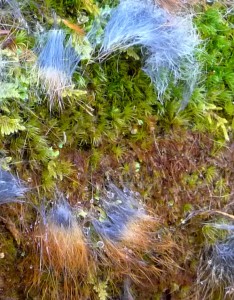 Crouching beside him, I offered thanks and apology—poor compensation for what I had taken—and thought how strange this brief hunt had been. In years past, I had never even seen a buck on opening day.
Crouching beside him, I offered thanks and apology—poor compensation for what I had taken—and thought how strange this brief hunt had been. In years past, I had never even seen a buck on opening day.
The next morning, returning scraps to the forest, I paused by a pair of crisscrossed logs. The moss was festooned with clumps of fine, downy fuzz. Puzzled, I leaned over to look more closely.
Red squirrel. The ephemeral traces of another, winged, hunter’s kill.
© 2010 Tovar Cerulli
Coyotes, deer, and the very idea of ‘game’
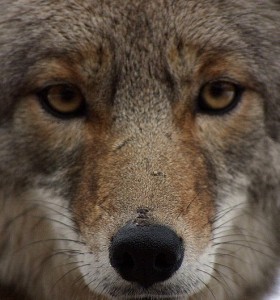
A few nights ago, coyotes yipped and howled nearby. I was delighted to hear them.
Granted, I was in bed at the time. My sentiments would, I suspect, be substantially different if I was, say, deep in the woods with a turned ankle and no flashlight.
The next day I got thinking about those wild yelps, and about coyotes.
Here in Vermont, some hunters are happy to have coyotes around, and never think of killing them. Other hunters despise coyotes and shoot them at every opportunity. Still others are somewhere in the middle: perhaps ambivalent, perhaps hunting them occasionally, perhaps happy to co-exist as long as Fido and Sylvester aren’t getting snatched from the backyard.
These hunters would, I imagine, respond in various ways to Aldo Leopold’s thoughts about predators on the land:
Harmony with land is like harmony with a friend; you cannot cherish his right hand and chop off his left. That is to say, you cannot love game and hate predators; you cannot conserve the waters and waste the ranges; you cannot build the forest and mine the farm. The land is one organism.

What catches my eye in that passage is the word “game.”
As a broad category, of course, it simply indicates creatures that we hunt or catch. “Game” says deer, not shrew. It says grouse, not egret. It says bass, not minnow.
But doesn’t it also say something else?
By saying “game,” don’t we stake some kind of claim on these creatures? Don’t we define them as somehow different from other “wildlife,” perhaps one step closer to “livestock,” to “property”?
When hunters talk about what impact coyotes do or don’t have on white-tailed deer numbers, isn’t the entire discussion built on the very idea of “game”? On the notion that deer—almost like cows and sheep, or Fido and Sylvester—are, at least in part, off-limits to coyotes?
What are the consequences of believing that certain wild animals should be killed and eaten only—or at least mostly—by two-footed predators, not four-footed?
© 2010 Tovar Cerulli
Snake food: Humans as prey
The sound was quiet, but close: a rustle in the leaves a few feet from the hiking trail.
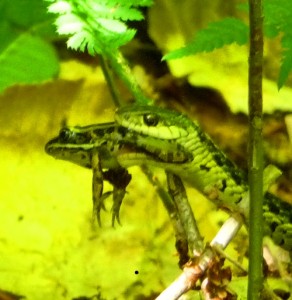 Curious, I peered under the ferns and caught sight of a garter snake. Then I saw what it was up to.
Curious, I peered under the ferns and caught sight of a garter snake. Then I saw what it was up to.
Not one of Mr. Frog’s better days.
The image of the amphibian in that reptile’s maw reminds me of the gargantuan snakeskin my father had when I was a boy. He had inherited it from some great-aunt who had traveled overseas. I suspect it was a reticulated python.
Now and then, I would take it out of the closet and unfurl it, fold by fold, until I had the entire skin—some twelve to fifteen inches wide and twenty-plus feet long—stretched across the ground. The desiccated skull, still attached, smelled faintly of stale decay.
I was fascinated by the sheer size of the thing.
I knew that snakes this large could eat pigs. Why not a small boy?
Examining that snakeskin was one of my earliest encounters with the idea of humans as potential prey. Not just creatures inevitably recycled in the web of life, as I touched on in one of my first blog posts, but creatures potentially hunted and eaten. For most of the last hundred millennia, Homo sapiens devoted a good deal of attention to avoiding other predators. In some parts of the world, we still have to be careful.
As a hunter, I wonder: What would it be like to end as prey?
That depends, I suppose, on how swiftly the predator accomplishes its lethal aim. The frog in the photo looks calm enough, but I don’t relish the thought of death by digestion. Faster than cancer, to be sure, but not exactly appealing.
Death by grizzly, though? Or by cougar? Given the option, those are tickets I might take.
© 2010 Tovar Cerulli
Feathers in the snow
First, a downy tuft. Then a barred tail feather. I scanned the path ahead and the woods to either side. Usually, when I find a few grouse feathers, there are more nearby, then more, then the spot where it happened.
This time, I did find more feathers, perhaps a couple dozen. But no epicenter.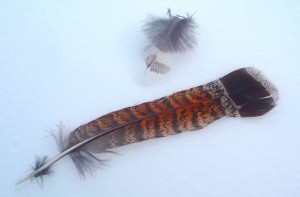
One tail feather, caught a few feet off the ground among the snow-laden branches of a hemlock sapling, suggested a dramatic scene: a hawk or owl swooping, taking its prey on the wing—or off a branch above—and carrying it off for dinner. That’s how most ruffed grouse go, snatched by a raptor.
I sympathize with both hungry predator and wary prey, and am awed by both: the powerful strike of one bird, the subtle camouflage and evasive maneuvers of the other.
These kinds of predatory encounters happen all the time—birds, bugs, fish, amphibians, reptiles, and mammals eating each other constantly. Yet, in our daily lives, we rarely see such nutritional transactions. And in our animated films—pale, distorted parables of nature that they are—animals rarely eat; miraculously, predators and prey become buddies.
It’s easy to forget about all the eating. Like the raptor swooping overhead, prey in talons, it hardly touches the ground of our consciousness.
When our thoughts do turn to nature and eating and humans, we know where we stand. At the top. You’ve probably seen the slogan on T-shirts and bumper stickers: “I Didn’t Claw My Way to the Top of the Food Chain to Eat Vegetables.”
It’s quite a fantasy—linear, neatly avoiding the cyclical truth of our own mortality. For we, too, are part of nature. We’re like the large carnivores who “in the end,” as Paul Shepard once put it, “are pursued by microbes, fungi, and plant roots.”
If you stop to think about it, there’s beauty here. The nutrients of our bodies becoming part of field, forest, and stream. Perhaps part of grouse or hawk, or drawn up into the stem and needles of the small hemlock where the grouse feather alights.
Omnivorous predator though I am, I think the T-shirt should read: “I Clawed and Clawed But Couldn’t Escape the Food Web – Soon I’ll Be Feeding Vegetables.”
© 2010 Tovar Cerulli
